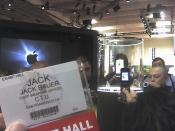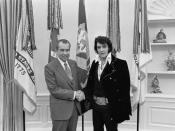Primary Colors
In 1972, the nation was shocked to learn that their elected president, Richard Nixon, was scheming to win re-election. The Committee to Re-Elect the President had men break into an opponent's hotel and set-up bugging devices to track their tactics and dealings. Worse, however, was the news that the President, having denied involvement, had tried to secretly divert investigators of the break-in. It was seen as deception, lies and betrayal to the public.
Suddenly a nation of people who had fought for their country and stood behind their president became faithless of their system and political leaders. With one man, the word politician brought on a dirty connotation: manipulation, greed, self-service. Now, thirty years later, the nation has still not recovered. In fact, an entire industry has risen in the media and between rival partisan groups to prove the opponent as a "dirty crook," to prove him to be like Nixon, like everyone else--mortal.
When the film Primary Colors was released in 1996, written by a true Bill Clinton supporter, Joe Klein, controversy abounded. The film followed the primary presidential campaign of Jack and Susan Stanton, characters clearly based upon Bill and Hillary Clinton. Partially inspired by the media's interpretation of the Clintons, it painted the picture of a new kind of dirty crook--one who had broken no laws, was a man of good principals and had a true dedication to the country, but who nevertheless had a moral corruption--a compulsion for sexual escapades and crude language. This was a man who loved his country and the people, perhaps more than anyone else on the ballot. But he was not perfect. And in a modern age, when the media is readily accessible and has few ethical standards to speak of, imperfections go a long way to creating...


